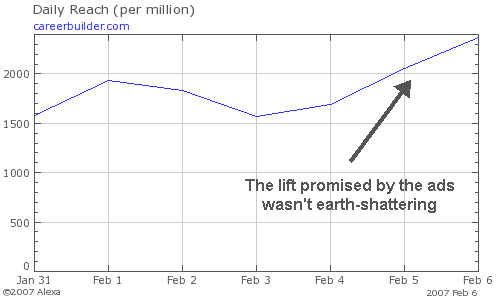Two of my favorite sites use a technique to make their short, punchy web copy even stronger.
- 37signals is a smart, irreverent Web 2.0 developer of web-based collaboration and development solutions. I’ve praised one of their products in this blog: Basecamp, an ASP alternative to MS Project. They market their products through a web site and attached blog that aren’t afraid to break with convention. That includes the way they draw your attention to important sales copy.
- Very Short List (VSL) does the same. It’s a fun, free subscription email and web site that delivers a list of exactly one interesting product, service or web site every single day. The copy they employ to describe each “VSL” is always short and clever. To further aid in scanning, VSL highlights important points in their message.
 Both use the technique you see in the sample graphic (click to enlarge). They use a text highlighting technique that any web site could adopt but few do. It’s a clean if somewhat “cute” alternative to bold and italics.
Both use the technique you see in the sample graphic (click to enlarge). They use a text highlighting technique that any web site could adopt but few do. It’s a clean if somewhat “cute” alternative to bold and italics.
Is this new formatting based on science? In other words, do metrics exist to show that this technique improves readership, or helps convert readers into customers?
No. Josh Fried of 37signals admits in Copyblogger.com, “We don’t have metrics [to support our design changes]. It’s all gut.” (I agree wholeheartedly by the way, with Brian Clark, author of Copyblogger.com. He cautions in this post that listening to designers and one’s instincts can be a dangerous practice when the outcome could be a major decline in the bottom line of your business.)
So right now web marketers appear to be flying blind when they are using this technique to showcase important copy. This could be remedied.
I’ve made a point to talk to anyone I know who conducts eye tracking heatmaps to see if they’ve ever seen any evidence that this hinders or helps a reader through the thicket of online copy. And if they haven’t, would they like to give it a try?
In the meantime, I welcome your thoughts on whether this hip spin on copy formatting will prove to be more than a novelty.
 Doritos tore a page from the new media playbook. They announced the challenge under a tight deadline — late last year — and opened the videos to American Idols-like voting, thus absolving themselves of responsibility for a bad choice. In an additional, shrewd move, they ran the winner early enough in the game to call it “world’s first fan-produced Superbowl ad.” The winning ad was only so-so in effectiveness — unless you consider the ad’s budget and production timeline (two digits and four days).
Doritos tore a page from the new media playbook. They announced the challenge under a tight deadline — late last year — and opened the videos to American Idols-like voting, thus absolving themselves of responsibility for a bad choice. In an additional, shrewd move, they ran the winner early enough in the game to call it “world’s first fan-produced Superbowl ad.” The winning ad was only so-so in effectiveness — unless you consider the ad’s budget and production timeline (two digits and four days).